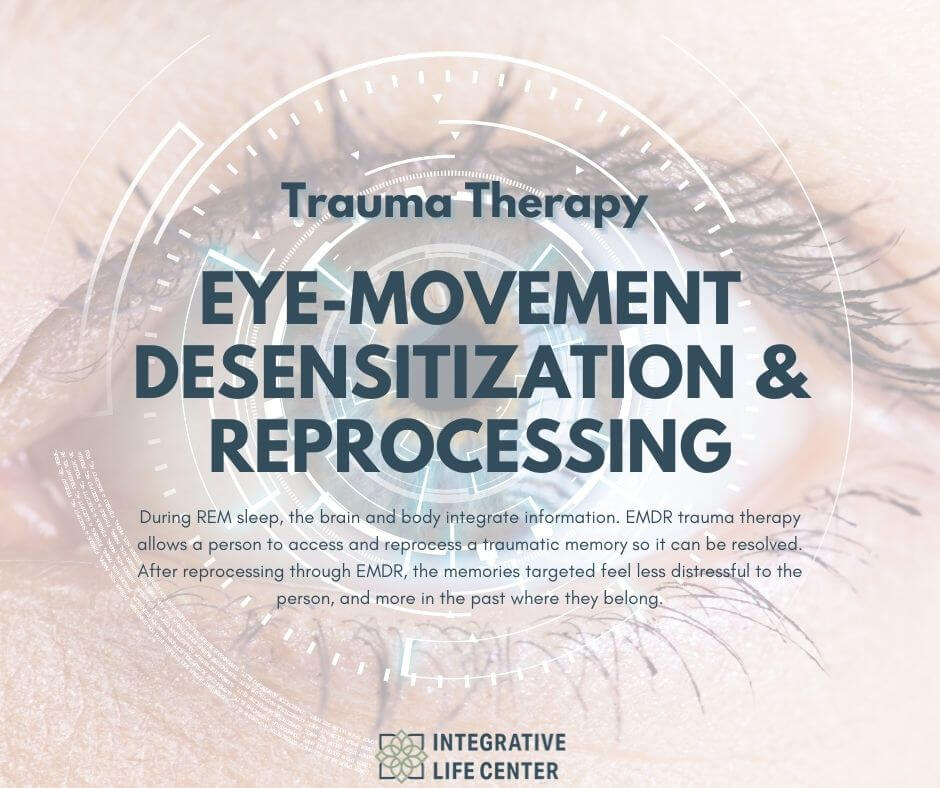EMDR Trauma Therapy is one of the most successful treatments for post-traumatic stress disorder (PTSD) and also a good option for many other types of trauma and mental health issues.
What is EMDR?
Eye Movement Desensitization and Reprocessing (EMDR) is a therapeutic technique developed by Francine Shapiro in the 1980s. Shapiro discovered that eye movements similar to REM sleep could alleviate stress from traumatic memories. During REM sleep, the brain and body integrate information. EMDR trauma therapy allows a person to access and reprocess a traumatic memory so it can be resolved. After reprocessing through EMDR, the memories targeted feel less distressful to the person, and more in the past where they belong.
Sometimes when you experience a traumatic event, it is too much for you to handle. Instead of processing it, you hold onto the pain and the memories associated with it continue to bother you. This happens with PTSD, but also with other trauma. EMDR can help you to put the traumatic event in a new perspective. It also brings quick relief when you are feeling a lot of pain.
Consider that a traumatic experience is similar to having a splinter in your hand. If you leave the splinter in, it continues to hurt you. When you pull the splinter out, it may hurt more at first, but then it begins to heal. EMDR targets traumatic memories that have been causing the person distress for a long time. Once reprocessed, those memories may hurt more initially, but then the brain heals itself and the target is stored in long-term memory. This makes it feel less distressing and allows the person to move forward. The memories are not changed, but stored in the past, and they feel less emotionally charged than they did before.
How is EMDR Different From Other Therapies?
With EMDR, you don’t have to go into extensive detail about the traumatic event you experienced. The therapist can guide you as you move through memories without knowing exactly what happened. While most traditional psychotherapies focus on changing thoughts, feelings, or behaviors, EMDR allows the brain to heal itself naturally.
EMDR works quickly. While a person may need to attend traditional psychotherapy for long periods of time, sometimes even years, they may heal from the same trauma in only a few sessions of EMDR.
An EMDR trauma therapist is a licensed mental health professional just like other therapists. The difference is that they have been trained and certified in EMDR.
What is EMDR and how does it support recovery?
How Does EMDR Work?
EMDR strives to reprocess painful memories and replace negative thoughts and feelings with positive, healthy thoughts and feelings.
Neurobiology of EMDR
The brain can recover from traumatic memories through communication of the amygdala (the fear center that signals stressful events), the hippocampus (memory center), and the prefrontal cortex (which analyzes behavior and emotion).
Not all traumatic memories are resolved on their own. It is instinctual to have a response to stress, typically to fight, flee, or freeze. A person can become overwhelmed by distressing memories and feel “frozen in time”. Processing through EMDR trauma therapy can resolve the fight, flight, or freeze response, allowing the brain to resume healing.
Eight Phases of Treatment
There are eight phases that are implemented during a session of EMDR.
1. History and Treatment Planning
The therapist will take your history, assess readiness, and develop a treatment plan. Potential target memories for EMDR will be identified together. Distressing memories, current situations, and childhood events may be targets.
2. Preparation
The therapist will make sure you know multiple ways to cope with emotional distress. They may teach you mindfulness, deep breathing, imagery, and other stress management techniques. These can be used during and in between sessions.
3-6. Assessment and Treatment
A target memory is identified and processed with EMDR. As a client you will identify:
- A visual image related to the memory
- A negative belief about yourself
- Emotions and bodily sensations
- A positive belief
You will rate the intensity of the distressing emotions and the positive belief. You will then focus on the memory, bodily sensations, and negative belief during bilateral stimulation through eye movements, taps, tones, or a light bar. This is EMDR processing.
You will be told to notice what happens, and identify what thoughts, feelings, sensations, or memories come up. The therapist will direct you through several sets of processing. When no distress remains, they will ask you to focus on your preferred positive belief. At the end of the processing phase, you will again rate the distress level and how strong the positive belief feels.
7. Closure
Your therapist may ask you to document anything related that comes up during the week. This may be dreams, memories, and other content. You will be reminded to use the coping activities in phase two as needed to calm yourself between sessions.
8. Evaluation
During the next session, your therapist will ask you to examine your progress, and your therapist will also evaluate where you are in treatment and may suggest or help you identify other targets for processing.
Effectiveness
EMDR trauma therapy is recognized as an effective treatment for trauma by the American Psychological Association, World Health Organization, and Department of Defense. Many people with PTSD have no longer had the disorder after 3-6 sessions of EMDR.
EMDR can decrease hallucinations, delusions, depression, and anxiety, and has been proven more effective than exposure therapy for symptom reduction. Studies have shown that EMDR’s results are maintained long-term. EMDR can improve self-esteem and may be useful in managing chronic pain.
Who Can Benefit From EMDR?
While EMDR was originally thought to be a treatment for PTSD, it can help with a variety of different conditions, including:
- PTSD and other trauma and stress related issues
- Anxiety
- Panic attacks
- Phobias
- Depression and bipolar disorders
- Dissociative disorders
- Personality disorders
- Eating disorders
- Complicated grief
- Sleep disturbances
- Substance use and addiction
- Low self-esteem
- Sexual dysfunction
- Chronic illnesses
- Chronic pain
EMDR at Integrative Life Center
ILC uses an EMDR trauma therapy protocol to help people heal from substance use disorder and other mental health issues. Emotional pain can be difficult to heal from. It can take time, but EMDR can help move through the process faster and allow the person to begin healing again. Because the person can return to normal functioning quickly, it increases their well-being and improves quality of life. If you or a loved one are struggling with trauma, don’t hesitate to contact us to find out if EMDR is right for you.




